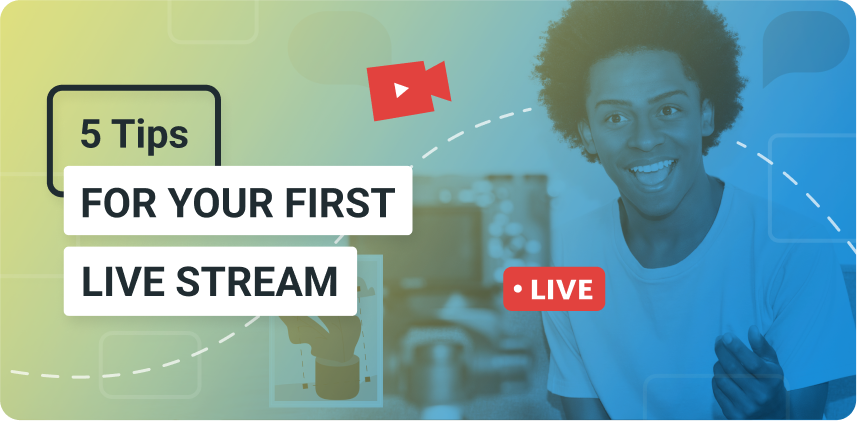Underestimating your live streaming audio quality might cost you way too many viewers.
In just a few short years, live streaming has boomed. Video creators around the world realize that live streaming connects and engages their audience more intimately than pre-recorded videos. That’s why it is imperative that all elements of your live stream, including audio, are 100% optimized.
Sound is the most important element that can convey your message to the audience, even more so than the visuals.
Dismissing audio quality or thinking any sound is good enough is a mistake that you cannot afford to make in these times. You don’t want to end up streaming a mute video as your audience stares dumbly at the screen.
Live streaming audio optimization
- High-quality equipment
- Mic placement
- Background noise
- Too little or no sound
- Soundchecks
Want to live stream like a pro? Download ManyCam for free!
How to optimize your live streaming audio and avoid sound issues
Invest in high-quality equipment
Nowadays, high-quality technical video equipment can come at an affordable price. Investing in a decent mic can help you optimize your live streaming audio quality and leave you with a happy audience.
Although video quality has improved by leaps and bounds in the past 10 years, the same cannot be said for audio instruments like your onboard microphone. Depending on your budget, you can still find some great mics.
If you want to make your live stream sound professional but do not want to invest in heavy and costly audio equipment, a good quality Lavaliere mic is your best bet.
These mics are small and can be clipped to your shirt. They are connected to your headphone jack by thin wires that can be concealed inside your shirt and can produce broadcast quality sound for your video.
If you are streaming a live event via your smartphone, you can also find high-quality digital condenser microphones in the market which can help capture crystal-clear audio, particularly in loud settings like a concert or a gala.
Mic placement
No matter how high-quality your mic is, your audience won’t be able to hear an impeccable sound if the placement of the mic is not right. If you can, invest in a high-quality unidirectional microphone and place it as close to the source of sound as possible.
If you are recording a live event, like a concert, coming too close to the speaker is not possible. However, there are ways around that. You can experiment with different kinds of mics and place them in various locations with reduced background noise to find out what works best for you.
Background noise
You will be surprised to find out how background noises can become highly distracting when you are broadcasting. Sounds that you might not even register can dramatically affect your live streaming audio quality.
Although you cannot always get rid of all the background noise, it is still worth it to do some research. Spend time reducing ambient noise, like the chatter of birds or the hum of electronic equipment.
If you are using a sophisticated piece of audio software, no doubt there will be controls in it with various options for removing background noise.
You can also muffle the ambient noise in your room, by placing drapes and carpets in the room, closing the doors and windows, and using homemade soundproofing panels to block out unwanted noise.
Too Little or No Sound
When you are sending a stereo signal to your live-streaming host, you may hear some people complaining the audio is not there at all.
Sometimes, the issue is partly due to the audience. They may be listening from a single earbud, but the audio is panned on the other side of the mix. Hence, if you are sending a stereo mix, a good practice is to pan the audio to the middle when you are speaking.
That way, the audience will be able to hear you from either earbud.
Sometimes, your audience may be hearing too little sound. The easiest solution may be to turn up the volume. But, sometimes something else goes wonky, and the sound engineer cannot detect what’s amiss.
In this case, if you are encoding using a computer, you will need to check the audio in the control panel or system preferences as well as the encoding software.
Doing a Sound Check
The trickiest part of the live streaming is that you don’t really know what your audience is hearing — or if they hear anything at all. To ensure that everything sounds as it should, you should do a soundcheck.
The simplest way to do that is to plug in your headphones directly into the camera and listen to the sound quality yourself. This gives you a more accurate impression of what your viewers are hearing.
Another way to check your sound is to do a quick rehearsal.
Before going public, set up a private broadcast with a friend who can let you know whether they everything without any issues on their end. Or, record your private broadcast and watch it to make sure you are happy with the quality.
Final Thoughts
The importance of live streaming audio tends to be mostly underrated. But, like podcasts and other audio-only content pieces out there, audio is more relevant than ever. Many “viewers” aren’t actually watching your live broadcast. They are listening to it. So, when the sound of a stream isn’t up to par, they definitely don’t stick around.
If you love to live stream, optimizing your audio can increase the chances of engagement and conversion. The above tips are just a few ways you can improve the sound during a live streaming session.
How do you set up your live streaming audio?

Want more tips on how to gain more engagement with your live streams?
The Absolute Live Streaming Guide to Engage Your Audience
Unless you maximize the live streaming interaction with your audience, you might be better off recording videos on-demand. It’s time to engage your audience! (Continue reading)
What You Need to Know to Increase Engagement on Live Streams
Live video is a great way to deliver impactful content and reach a broad audience. The challenge is how to get people’s attention and maintain it. Research shows that our average attention span is… (Continue reading)






